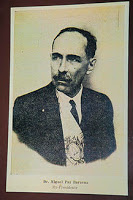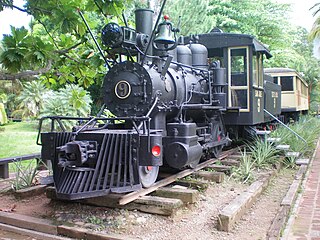 |
|---|
General elections were held in Honduras over three days, beginning on 28 December 1924. Miguel Paz Barahona was elected president and his National Party won all but one of the seats in Congress.
 |
|---|
General elections were held in Honduras over three days, beginning on 28 December 1924. Miguel Paz Barahona was elected president and his National Party won all but one of the seats in Congress.
National Party candidate Tiburcio Carías Andino emerged as the leading candidate in the 29 October 1923 presidential elections with 47% of the vote, but failed to win a majority, meaning Congress would have to confirm the winner. Congress, which was controlled by liberals, refused to confirm Carías as the winner. In a Congress vote, 18 voted for Juan Ángel Arias (who had finished third in the popular vote), 15 for Carías and nine for the runner-up Policarpo Bonilla. This led to a two-month civil war starting in February, referred to as the War of Revindication. As a result, American marines were sent into Tegucigalpa to restore peace. [1]
An agreement was signed on the USS Milwaukee on 3 May 1924, which provided for a provisional government led by Vicente Tosta to hold power until fresh elections were held. Participants in the civil war were banned from contesting the presidential election. [1] A new constitution was subsequently drafted and promulgated in September. It introduced residency requirements for Congressional candidates and required presidential candidates to be aged between 30 and 65. [1]
While Miguel Paz Barahona was nominated as the National Party candidate, with the United States objecting to the candidacy of Tiburcio Carías Andino, [2] who had won the 1923 elections.
The Liberal Party did not put forward a candidate. [3] [4]
| Candidate | Party | Votes | % | |
|---|---|---|---|---|
| Miguel Paz Barahona | National Party | 72,021 | 91.76 | |
| Other candidates | 6,470 | 8.24 | ||
| Total | 78,491 | 100.00 | ||
| Source: MacCallum, [5] Department of State | ||||
| Party | Seats | |
|---|---|---|
| National Party | 46 | |
| Liberal Party | 0 | |
| Others | 1 | |
| Total | 47 | |

Honduras was inhabited by many indigenous peoples when the Spanish arrived in the 16th century. The western-central part of Honduras was inhabited by the Lencas, the central north coast by the Tol, the area east and west of Trujillo by the Pech, the Maya and Sumo. These autonomous groups maintained commercial relationships with each other and with other populations as distant as Panama and Mexico. Honduras has ruins of several cities dating from the Mesoamerican pre-classic period that show the pre-Columbian past of the country.

Tiburcio Carías Andino was a Honduran politician and military officer with the rank of major general. He served as the 38th president of Honduras, briefly in 1924 as constitutional president and later in the form of a dictatorial regime from 1933 until 1949. He was elected president of Honduras in the midst of the Great Depression. He strengthened the Armed Forces, maintained the support of the banana companies by opposing strikes, strongly aligned its government with that of the United States, and kept the country in strict adherence to debt payments.

Miguel Paz Barahona was President of Honduras from 1 February 1925 to 1 February 1929. Barahona was a member of the National Party of Honduras (PNH).
Vicente Tosta Carrasco. Honduran politician. He was the thirty-fifth president of Honduras; a provisional President of the Repuplic of Honduras for ten months, from 30 April 1924 through 1 February 1925.

Honduras is a republic in Central America, at times referred to as Spanish Honduras to differentiate it from British Honduras, which became the modern-day state of Belize.

Authoritarian General Tiburcio Carías Andino controlled Honduras during the Great Depression, until 1948. In 1955—after two authoritarian administrations and a general strike initiated by banana workers—young military reformists staged a coup that installed a provisional junta and paved the way for constituent assembly elections in 1957. This assembly appointed Ramón Villeda Morales as president and transformed itself into a national legislature with a 6-year term.
Direct popular general elections were scheduled in Honduras for 13 October 1963.

General elections were held in Honduras on 10 October 1954. The elections were relatively honest. and saw Ramón Villeda Morales of the Liberal Party emerge as the most popular presidential candidate with 48% of the vote. However, the constitution required Congress to confirm the president if no candidate received a majority in the popular vote. The Liberals did not have a majority in Congress, and the National Party and National Reformist Movement (MNR) agreed to block Villeda's candidacy, although they were unable to agree on a candidate of their own. The two parties boycotted the confirmation session in November – an idea proposed by US Ambassador Whitting Willauer – meaning those present did not form a quorum.

General elections were held in Honduras on 10 October 1948. The elections were boycotted by the Liberal Party as the party was restricted from campaigning. Instead, they called for the electorate to abstain from voting.

General elections were held in Honduras on 28 October 1932. Voters went to the polls to elect a new President of the Republic and a new Congress.

Constituent Assembly elections were held in Honduras on 26 January 1936.

General elections were held in Honduras on 28 October 1928. Vicente Mejía Colindres of the Liberal Party was re-elected as president, becoming the first incumbent to be re-elected in peaceful and contested elections.

General elections were held in Honduras between 27 and 29 October 1923. Tiburcio Carías Andino received the highest number of votes, with 47% of the ballots cast. However, as no candidate had received an absolute majority in the public vote, Congress would vote on the candidates. However, Congress did not meet again until 1 January the following year. In December President Rafael López Gutiérrez declared a state of siege, suspended the constitution, and announced that he would remain in office in order to keep the peace. Although Congress was dominated by the two liberal parties, they did not want Carías, but also could not agree on a common candidate.
Modesto Rodas Alvarado was a prominent Honduran lawyer and politician who served as President of the National Congress of Honduras between 1957 and 1963.

The Presidential Palace of Honduras is the official residence of the president of the Republic of Honduras. Currently the president resides in the Palacio José Cecilio del Valle.
Visitación Padilla Irias was an educator and feminist activist.

Ana Rosalinda García Carías is a Honduran lawyer who served as First Lady of Honduras from 2014 to 2022, as the wife of President Juan Orlando Hernández.
The First Honduran Civil War or Revolution of 19 was an armed conflict that took place in the Republic of Honduras in 1919. This was the first conflict in Honduran soil where the weapons and technological advances of the 20th century were felt.
The Second Honduran Civil War or the Reclamation Revolution was the armed conflict that took place in the Republic of Honduras in 1924. This was the first conflict in Honduras where airplanes were used for aerial bombardment, and new war tactics inherited from the First World War were employed.
Abraham Williams Calderón was Honduran politician. He was known as Vice President of Honduras during the administration of Tiburcio Carías Andino and president of the National Congress of Honduras, and presidential candidate of the Revolutionary Nationalist Movement in the 1954 elections.